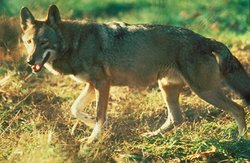Red Wolf
|
|
| Red Wolf Conservation status: Critical | ||||||||||||||
|---|---|---|---|---|---|---|---|---|---|---|---|---|---|---|
| Missing image Redwolf-tn.jpg Red Wolf | ||||||||||||||
| Scientific classification | ||||||||||||||
| ||||||||||||||
| Binomial name | ||||||||||||||
| Canis rufus Audubon and Bachman, 1851 |
The Red Wolf (Canis rufus) is the rarest and most endangered of all wolves. It is thought that its original distribution included much of eastern North America, where Red Wolves were found from Pennsylvania in the east to Texas in the south. In the last century, however, persecution, habitat destruction, and hybridization with Coyotes has brought the Red Wolf to the brink of extinction. Only about 270 remain; about 100 reintroduced into the wild in North Carolina and 170 in captivity. Historical habitats included forests, swamps and coastal prairies, where it was an apex predator.
Traditionally, three subspecies of Red Wolf have been recognised, two of which are extinct. Canis rufus floridanus has been extinct since 1930; Canis rufus rufus was declared extinct by 1970; and Canis rufus gregoryi, the surviving subspecies, became extinct in the wild by 1980.
| Contents |
Anatomy
The Red Wolf is a medium-sized canid, smaller and more slender than the Grey Wolf but larger than the coyote. Adult males weigh between 25 - 35 kilograms (60 - 80 pds) while females are generally two-thirds this range. Their coats may take a variety of colours: black, brown and grey through cinnamon and yellow. The reddish coats for which they are named was typical of some Texan populations. In the wild average life spans are estimated as low as four years; in captivity this rises as high as fourteen years.
Habits and Social Structure
Red wolves are shy and wary creatures. They prefer to hunt alone or in small family groups; pack sizes are smaller than those of their grey cousins, consisting often of one adult pair and their offspring.
As in other canids pair-bonding is strong and red wolves mate for life. They mate yearly and two or three pups are usually born in the Spring. Both parents help raise the offspring who are mature enough to leave behind parental support at six months of age.
Their diet consists of any available small animal, including rabbits, raccoons and rodents. They occasionally bring down deer and supplement their diet with insects and berries.
Taxonomy
The taxonomic status of the Red Wolf has long been controversial: the traditional view is that it is indeed a distinct species. An alternative view is that the Red Wolf is simply a recent hybrid between the Grey Wolf and the Coyote. In this view, Red Wolves arose when habitat loss and human disruption caused remnant Grey Wolf and Coyote populations to interbreed.
Extensive studies have thrown much light but little clarity on the question. On the whole, morphological, behavioural, and genetic evidence supports the view that there has been a distinct Red Wolf population for over half a million years, but much confusion and not a little controversy remains. There seems little doubt that there has been considerable hybridisation between Red Wolves, Grey Wolves, and Coyotes, and that in recent years the Red Wolf has declined and been replaced over most of its range by Coyotes and Coyote-Red Wolf hybrids.
In 1999, Brad White of McMaster University and Paul Wilson of Trent University found evidence suggesting that the wolves of south-eastern Canada (previously assumed to be Grey Wolves) were in fact Red Wolves, a view which has since found support in both fossil and morphological evidence. The Eastern Canadian Wolf, as this population has been named, ranges from Minnesota to Quebec.
One recent theory suggests that Red Wolves, Grey Wolves and Coyotes are all descended from a common ancestor population in North America between one and two million years ago. According to this theory, the ancestors of the Grey Wolf migrated to Europe and Asia at that time, becoming the Grey Wolf as we know it today, and then returned to the Americas about 300,000 years ago. At around the same time (300,000 years ago) the Coyote and Red Wolf populations diverged and began to differentiate. The modern Eastern Canadian Wolf population, in this view, is a mixture of different blood lines, including pure Grey Wolves, pure Red Wolves, and hybrids between Red Wolves and Coyotes, and Red Wolves and Grey Wolves. Grey Wolves and Coyotes do not hybridise directly.
The upshot of the taxonomic debate is not simply a matter of accurate classification: although the actual patterns of evolution are complex and subtle, human classification schemes usually rely on relatively simple, hard-edged divisions, such as the concept of species, which is ill-adapted to describing the wolves of North America. It remains a crucial concept, however, as many environmental policy decisions revolve around the species concept. In law, a distinct "species" is much better protected than a "mere subspecies". The Grey Wolf-Red Wolf-Coyote dilemma is a striking example of the fact that the forces driving speciation, although working at a geological timescale, sometimes arrive at what seems to humans as an intermediate position. While by now proven to be distinct phylogenetic species, the two wolves and the coyote have not reached a sufficient state of reproductive isolation to be considered true biological species - that is, each one forms a distinct evolutionary lineage, but at least due to human intervention, over time the Red Wolf lineage would probably be 'absorbed' back into those of the other two species, as it still can hybridize with both.
See also
- Maned Wolf, a separate canid species called Red Wolf in Brazil.
External links
- The Wolves of Algonquin Provincial Park ? A Report by the Algonquin Wolf Advisory Group (http://www.mnr.gov.on.ca/MNR/pubs/wolf_report_opt.pdf) (PDF)
- Wolf added to Species at Risk list: Ontario must act (http://www.wolf.org/wolves/news/news_apr_jun_01/05_03_01ontario_wolf.asp)bg:Червен вълк
da:Rødulv de:Rotwolf he:זאב אדמוני it:Canis rufus ja:アメリカアカオオカミ nl:Rode wolf no:Rødulv pl:Wilk rudy

